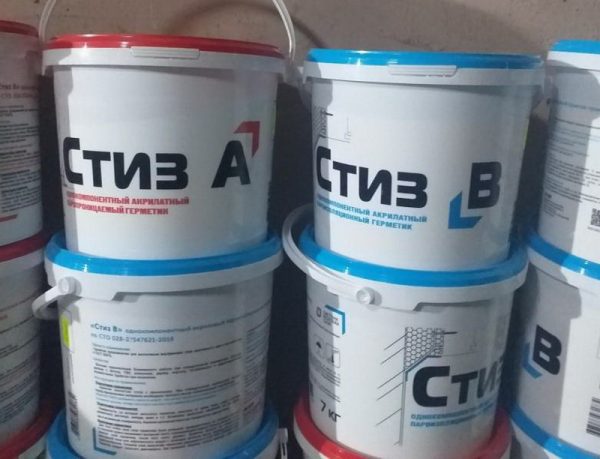Installation of plastic windows requires strict adherence to technology. It is important to properly seal all joints and seal the seams, otherwise moisture, dirt will get into them, and the thermal insulation of the room will be violated. Sealant "Stiz-A" - one of the best tools that perfectly fits on top of the mounting foam or is used independently. It allows for reliable sealing of the seams and fix the tides.
- Description of sealants "Stiz-A" and "Stiz-B"
- Specifications and Composition
- Advantages and disadvantages
- Application Rules
- Material consumption
- Storage recommendations
- Is it possible to use “Stiz-B” instead of “Stiz-A” and vice versa
- Sealant "Stiz-D"
- Advantages of Stiz-D
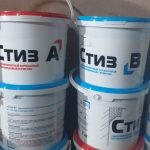
Description of sealants "Stiz-A" and "Stiz-B"
Sealant “Stiz-A” has been present on the market for construction products for more than 20 years. Its manufacturer - CJSC SAZI - produces a huge number of adhesives, compounds, sealing compounds. The product is produced according to GOST 30971, it is easily applied to various surfaces, including areas with limited access. After polymerization, the sealant turns into a durable waterproof seam in white. In addition, the material is available in dark gray, light gray, brown. At the request of the customer, other pigments can also be introduced into it.
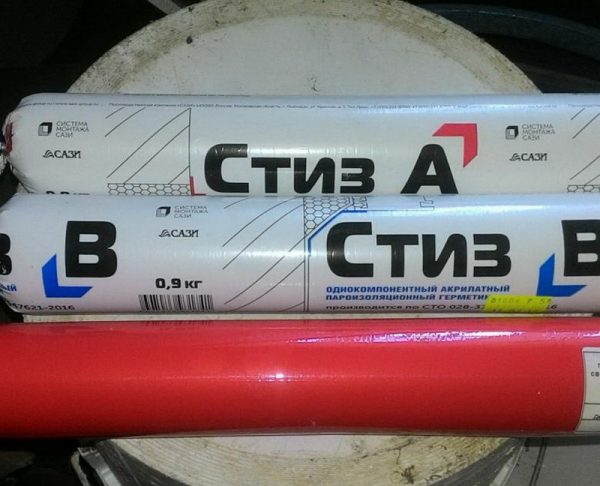
"Stiz-A" is a one-component composition based on acrylic. This is a pasty, viscous-flowing plastic mass, which, as it hardens, continues to remain elastic. The acrylate mixture at the base of the sealant has high strength characteristics and powerful protective properties.
The most important feature of the product is its excellent adhesion to polymers, so the installation and repair of plastic windows is considered its main area of application. Among other things, sealant can be used for such purposes:
- sealing of any street seams: cracks, voids in metal, wood, concrete;
- strengthening the outer layers of mounting joints;
- repair of buildings for residential, office, administrative, industrial purposes;
- insulation of cracks when attaching balcony mechanisms;
- restoration of cracks in buildings;
- protection of polyurethane foam from moisture, ultraviolet and moisture on different surfaces;
- fixing stained-glass windows.
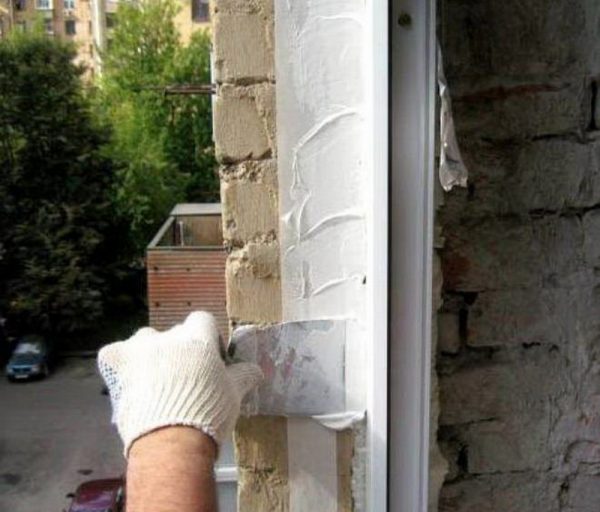
In some cases, instead of this product, it is better to use the Stiz-B sealant, which is intended for the treatment of internal joints. This is a one-component vapor barrier for closing openings of windows, balconies in buildings for any purpose. The product has vapor barrier properties, is resistant to deformation, has a long service life, and is characterized by excellent adhesion to many materials. Both sealants are available in plastic buckets of 3 and 7 kg, as well as in hard and soft cartridges of 310 and 600 ml.
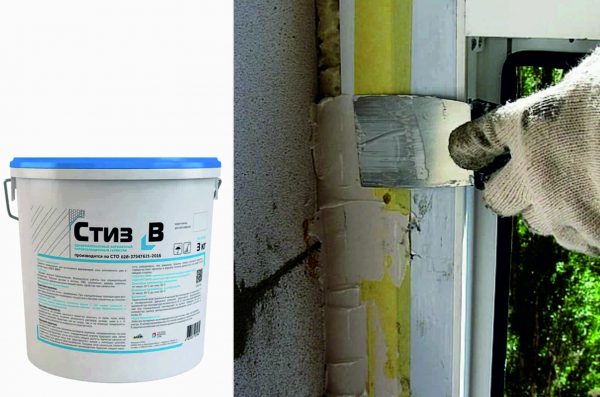
Specifications and Composition
Sealant “Stiz-A” is based on acrylic copolymers, providing it with basic operational properties. The product also contains defoamers, ammonia, thickeners, plasticizers and elastomers. The composition introduces antiseptic additives that prevent the growth of bacteria and fungi.
The sealant is sold in finished form, it does not require the addition of hardeners or mixing before application. The main properties and technical parameters of the composition:
- thixotropy (does not drain from vertical bases);
- suitability for most building materials (brick, plastic, concrete, plaster, aluminum, PVC, foam concrete, wood);
- resistance not only to static loads, but also to vibration, deformation and shear;
- vapor permeability, ability to drain condensate;
- shrinkage to the minimum limits (no more than 20%);
- stretching to rupture not less than 250%;
- primary film formation in 2 hours;
- the period until complete polymerization - 48 hours;
- service life of the sealing joint - 20 years;
- application temperature - from –10 to +35 degrees;
- operating temperature - from –60 to +80 degrees;
- the possibility of freezing and storing the composition for up to 30 days.
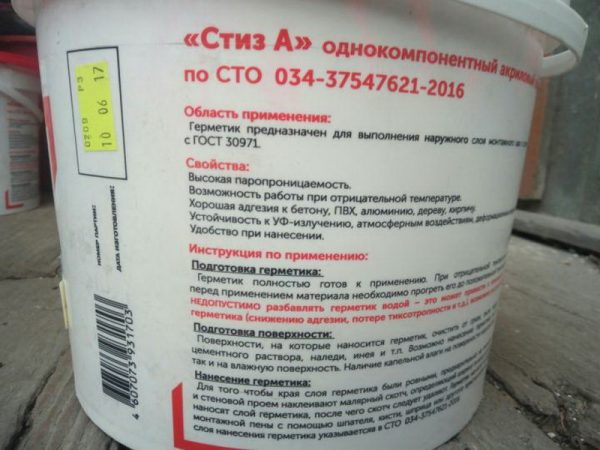
to contents ↑It is possible to apply sealant even on a damp base, which is very important during outdoor work. After curing, the seam will be dull in appearance, immediately gain resistance to UV rays, atmospheric factors. If necessary, the sealant layer can be painted or plastered.
Advantages and disadvantages
“Stiz-A” has a high degree of adhesion, therefore it adheres reliably to materials and does not cause corrosion or rotting. Its vapor permeability is so high that the indoor climate will not be disturbed, the fungus and mold will not settle, which happens with excessive humidity in the house.
Other advantages of the composition:
- simplicity of work - even a beginner can handle it;
- lack of need for connection of components;
- the ability to apply to inclined, vertical, horizontal joints;
- the elimination of damage under the influence of atmospheric factors for many years;
- extensive color line;
- tolerance of mechanical damage;
- strict compliance with GOST;
- frost resistance, suitability for severe climate;
- low shrinkage;
- excellent ductility;
- the possibility of coating coatings after drying;
- 100% quality guarantee from the manufacturer.
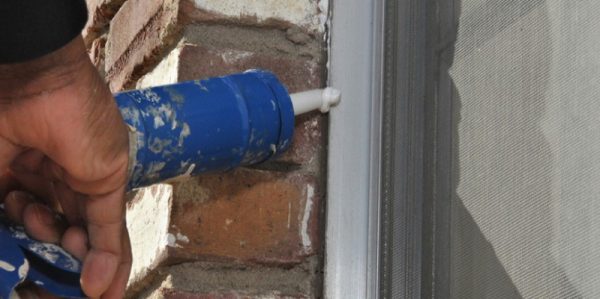
The disadvantages include a short shelf life of the product: even if the packaging is sealed, it will have to be thrown away in a year. The elasticity of the product is slightly lower than that of silicone sealants, therefore, for new buildings prone to shrinkage, it is better to use other compounds. Sealant "Stiz-A" after drying remains porous, therefore it is used as a last resort for internal work, it is better to replace it with a more suitable "Stiz-B". Otherwise, there is a risk of strong absorption of fumes, darkening of the seam and loss of properties.
to contents ↑Application Rules
Sealing of windows or other joints should be done only in dry weather. If the temperature is below zero, the sealant will have to be heated to +18 degrees (withstand in a heated room). It is strictly forbidden to dilute the sealant with water - this will lead to a decrease in its elasticity and other operational properties. To create a reliable and durable seam, you need to make sure that the boxes of the window blocks are firmly fixed with foam or otherwise.
Pre-paste the edges of the future seam with masking tape to make the joint perfectly smooth. Apply sealant with a mounting gun, which must be prepared in advance. It is most convenient to level the seam with a narrow spatula or a small brush. Sealant is also recruited and applied with a spatula, which is sold in plastic buckets.
Work order:
- excess foam is cut off with a sharp construction knife (the permissible pore size in the foam should not exceed 5–7 mm);
- wipe the base from dust, dirt;
- apply a sealant with a strip in the depth of the joint, avoiding breaks;
- within 10–20 minutes, level the layer with a spatula;
- immediately remove the masking tape until the seam is seized (if the tape was not pasted, then simply wipe off the excess with a rag);
- wait at least 48 hours to dry, then stain the seam, if necessary.
Material consumption
With a width of the sealing joint equal to 15–20 mm (standard size) and a thickness of 2 mm, about 70–80 g of sealant will be spent per linear meter. When these parameters increase, the flow rate will increase.
Storage recommendations
During storage, it is allowed to freeze and thaw sealant several times (no more than 10 cycles). In a closed container, the composition is stored at a temperature of –5 degrees for a year. After opening, it is advisable to immediately use a sealant, as it may dry out.
If simultaneous application is not possible, there are a number of methods that will help preserve the product remaining in the tube. Here is one of them:
- Press the composition so that the top of the tube is empty.
- Remove the piston, melt the plastic and press with pliers to seal the top of the package.
- Put hermetically sealed storage containers in a cool place.
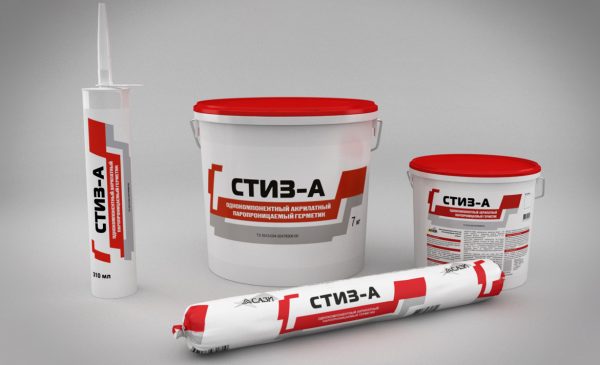
to contents ↑You can also shift the sealant into a glass jar, leaving the minimum possible air gap on top. After rolling the jar under the iron cover, put it in a place for storage where there is no access to the sun.
Is it possible to use “Stiz-B” instead of “Stiz-A” and vice versa
These funds are not interchangeable. "Stiz-A" is considered to be vapor permeable, which allows moisture to easily leave the seams. “Stiz-B”, on the contrary, does not allow water to enter the room, reliably sealing the internal joints. It is better to use both tools complete with each other.

Sealant "Stiz-D"
This tool is new in the market of sealing compounds. It has a special purpose and is used to create an additional layer in order to protect the adjacency of the window frame and walls from moisture. "Stiz-D" allows you to reduce heat loss in the room and improve the microclimate. The sealant is applied to door and window openings before mounting the structure. It is sold in banks of 3 kg. The consumption of funds is approximately equal to 25 g with a joint thickness of 80 mm.
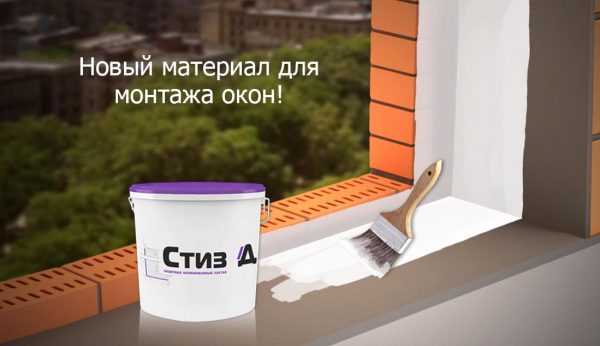
Advantages of Stiz-D
Using this sealant, you can seriously increase the maintenance-free life of a double-glazed window, both window and balcony, and door. The tool improves the water resistance and thermal insulation of the entire structure, reduces the risk of cracks in the areas adjacent to the walls. Ultimately, the sealant makes the room warmer. Its advantages:
- high adhesion to materials;
- good moisture repellent properties;
- ease in work;
- the possibility of applying at subzero temperatures;
- suitability for any buildings, constructions.
The tool can be combined with other sealants of this series. It is stored for no more than 6 months at a temperature above 0 degrees, provided that the integrity of the package is maintained. When working with sealant, it is necessary to exclude contact with skin, eyes, use protective gloves and be careful.
Sealant “Stiz-A” and its analogues allow to install or repair windows with high quality, have a long service life and really reduce heat loss in the room. Their use will exclude the appearance of drafts and freezing of windows, which is important for each customer of double-glazed windows and door structures.



